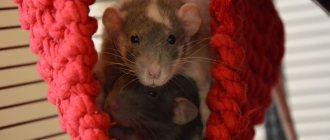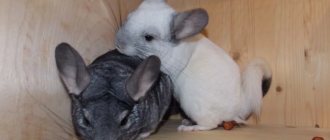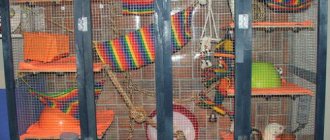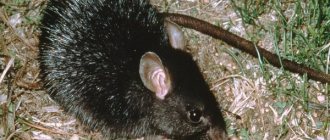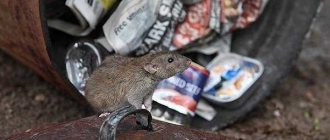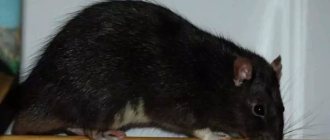Unique Fertility
In the Russian Federation the following types are most often found:
- Gray or pasyuk;
- Black;
- Turkestan (red).
Pasyuk Black rat Turkestan rat
One can only wonder why nature awarded rats with such amazingly productive fertility. They live and breed all over the world, not paying attention to either cold or hot climates, and their activity lasts all round. And only unforeseen natural disasters or any mass diseases can temporarily reduce their numbers.
Scientists believe that it was humans who contributed to changes in the behavior and survival of rats. Living next to a person, eating the products that he produces, these rodents live freely and comfortably. After all, food is always available, and all the traps prepared by people can be avoided. And if one rat was poisoned, the others will no longer approach such food. These animals have a fairly high intelligence. It is assumed that they have the makings of abstract thinking, which helps them navigate and stay alive in an unfamiliar place. All these skills are adopted by subsequent generations.
And considering how rats reproduce, all that remains is to start fighting them in time, because their activity in this case can take on catastrophic proportions.
Initial care of offspring
Newborn rats are difficult to feed and must be kept warm at all times. Infants raised without their mother should be stimulated to eliminate waste (with a damp, warm Q-tip or cotton swab).
A breastfeeding foster mother will give babies a much better chance of survival. Survival rate when grown independently is very low.
Newborn rats require food and drink. The healthiest initial feeding should be colostrum, a secretion from the mammary gland produced shortly after birth. It is rich in antibodies that help keep babies healthy. Colostrum also contains a lot of carbohydra.
Productive offspring all year round
Rats' minks are always clean and well-groomed. Having found shelter, they make additional passages and then deftly navigate through them. They find refuge for themselves:
- Digging a hole yourself;
- Having captured a hole already made by another small animal;
- By occupying a nest made by a bird or animal;
- Using any convenient building structures.
They live not only in families, there are also loners. Rats united in colonies pose a particular danger to people, since this form of organization can exceed the number of more than 1000 individuals. Of course, they also need a very large territory. In addition, they guard it very actively. Colonies are found primarily in large cities. Sometimes their number is equal to the population!
If you study the birth statistics of rats, you may get the impression that they are only busy reproducing. With the exception of northern populations, these animals reproduce throughout the year, but the number of pups born varies for each individual. For example, if this:
- The gray rat, on average, can give birth to up to 9 cubs in one litter, but sometimes their number reaches 20;
- The Australian species is distinguished by a smaller number of births - from 3 to 15;
- The Malayan species produces from 3 to 6 cubs in one litter.
However, rats also have enemies who happily eat them, helping people reduce the spread of dangerous rodents.
Veterinary intervention
At a veterinary practice, specialists may do an x-ray or ultrasound to see how many babies are left in the uterus, as well as their position. The female does not need to be sedated for x-rays.
- Oxytocin injection
Your veterinarian may try to induce labor with oxytocin. This is especially helpful for postpartum-exhausted rats whose contractions have become too weak to produce pups.
Oxytocin is a hormone produced by the pituitary gland that increases the ability of sodium molecules to pass into the muscles of the uterus, causing the uterus to contract. These muscle contractions move the babies through the birth canal. Oxytocin is also necessary during lactation. Oxytocin, given by your veterinarian, is a synthetic hormone that is used if your rat is having weak or no contractions.
Caution should be exercised when prescribing oxytocin. If the baby rat is positioned incorrectly or its large body is stuck in the birth canal, the stronger contractions produced by the medicine may cause the uterus to rupture. An x-ray will help your veterinarian visualize the babies' position and decide whether an injection of oxytocin is needed.
In some cases, labor begins after the first injection, but slows or stops again. In this case, repeat dosing may be necessary to ensure that all babies can be born. Oxytocin should not be administered to a rat during labor more than two or three times.
- Emergency caesarean section
A Caesarean section is a procedure in which the offspring is born by cutting the abdomen and uterus, as opposed to a normal birth.
Since it is impossible to give birth to babies and repair the uterus in rats, the procedure is a virtual sterilization. The uterus is removed and opened to save all viable children and the mother.
Your veterinarian should use all routine sterile surgical procedures, including sterile draping. The veterinarian may pre-treat the rat with Torbutrol or Banamine (for pain) and Glycopyrrolate (for heart protection). The rats will be given Isoflurane or Sevoflurane for surgery.
A female after a cesarean section will not be able to breastfeed due to stress after the operation and lack of hormones. Ask your veterinarian to give her pain medication. You give it to a rat at home - it is a very invasive and painful procedure.
Although not every emergency sterilization results in a live birth, often some or all of the children survive. They will need help to complete the birth process.
After the hysterectomy, a veterinarian will need to care for the mother while an assistant or more will help with the offspring. This needs to be done quickly. Babies stuck in the birth sac without oxygen may struggle to breathe and aspirate birth fluids.
Each uterine horn will be carefully cut so that none of the babies are harmed. When babies are removed, each sac will be carefully opened and the umbilical cord cut approximately 3.5cm from the body. Afterwards, babies will be wiped with a warm sponge or cloth. Next, they are dried by gently and constantly rubbing. It is important to make sure their mouth and nasal passages are clean. It's normal if they don't start breathing right away; it may take a few minutes of stimulation to breathe.
It is necessary to constantly rub babies and periodically bring them to a source of pure oxygen (to an oxygen tube during rubbing). This can even revive purple or blue babies.
What is the difference between rat reproduction?
In good conditions, a female rat can mate with several males at once. In the same way, males can find several females at once. Pregnancy lasts quite a bit: after three weeks, babies appear. They are still completely naked, blind and deaf, since the ear canals are closed. After two weeks, the eyes begin to open, and the pups begin to explore the surrounding space. The male does not take part in upbringing.
If there are weak individuals in the litter, sick, with pathologies, the mother mercilessly eats them. In this way, healthy offspring are regulated.
In just a month and a half, the rat will be able to feed itself independently, and is fully mature for adulthood. Young females at the age of 6 months are already ready to bear offspring.
And the mother’s body, a few days after giving birth, is already ready for new mating and bearing new pups. It so happens that she feeds some, while others are pregnant at the same time. Therefore, it is not surprising that the number of these rodents in some large cities is equal to the number of inhabitants.
Rats are especially productive if they are accompanied by very favorable conditions:
- Constant supply of food and water. They always want to eat. That is why it is so important for rats that their shelter is located near a food source in the form of a garbage dump, garbage chute, or food service unit;
- When there is a lot of vegetation around. These can be cultivated fields, grain farming, orchards and vegetable gardens. Many rodents prefer small invertebrates, insects, and young poultry;
- Warm weather conditions with high humidity.
If such favorable circumstances last for several seasons, the population increases markedly.
In general, rats live up to three years. And the older the female becomes, the greater the number of offspring she has. And she bears cubs 14 times a year, constantly looking for a new convenient place for the next nesting. And the problem often arises - how to get rid of rats in a barn, home, or enterprise, especially when more and more of them appear.
Once it has discovered a power source, the rat will clearly remember the way to it, and will also take care of its relatives, leaving a mark and thereby showing them the right path. And good food in large quantities helps to increase the number of offspring, and instead of the planned 7–9, 15–18 may appear.
Rats avoid contact with humans. They see very poorly, but they smell people. That is why, if you need to get rid of rats and mice in a barn, house, or local area, it is not recommended to make baits with unprotected hands. For these purposes, it is better to use rubber gloves.
The most popular methods of exterminating rats:
- Traps;
- Lures;
- Ultrasonic repellers;
- Folk methods.
The difficulty is how to get rats out of the barn using folk remedies, but such effective methods can greatly reduce the number of individuals.
Rats, like any living creature on earth, strive to give birth to their own kind. Some animals eat frequently and abundantly, some slowly and little. Rats, being rodents, reproduce very quickly. And that is why problems arise with their removal. In this article you will learn at what age rats can reproduce, how often they do it, how many rat pups are born in one litter, and much more.
Lifestyle
Elephants are considered the largest animals that can be found on land. These giants belong to the class of mammals and are very social animals. Their natural habitat is Southeast Asia and Africa.
Elephants live in families, and complete matriarchy reigns in families, and males are expelled from the herd at a young age (or they leave on their own). Adult males live solitary lives and approach the family only to mate with a mature female. An elephant family consists of the eldest elephant, her daughters (with children) and other female relatives.
By nature, elephants are nomads. It is the eldest female who leads her family in search of food, and she decides where to go, where and how long to rest.
These huge animals are very sociable and enjoy communicating with their own kind. Tactile contact plays a huge role in the life of giants. They touch each other with their trunks, stroke them as a sign of greeting, the older ones kick the younger ones as punishment
Members of the same family treat each other with great care; special care and attention is given to a sick or dying elephant
The question of how long pregnancy lasts in elephants has long remained controversial in scientific circles. But today, thanks to the observations, research and documentation of zoologists, much is known about the pregnancy period, childbirth and subsequent care of the baby of these powerful herbivores.
Wild conditions
The mating season for rats begins in the spring, both domestic and wild, i.e. Everyone has the same time to produce offspring. However, there are further differences.
In nature, the reproduction rate of rats is low. They mate only in spring and summer. This happens due to living conditions. If the region in which the population is located is cold and wet, mating rarely occurs. Usually this can be in the Far North, taiga, jungle, and so on. The opposite situation occurs if rodents live in a warm climate.
During mating, the male hunts for several females at once, after which each becomes pregnant in turn. The pregnancy itself lasts only a month, sometimes less. Before giving birth, the female arranges a nest for the future offspring: she collects straw, leaves, branches, digs a hole and lays out the collected materials there. Then he brings food there, the reserves of which should be enough for the first weeks of the little rats’ lives. Usually about ten or fifteen babies are born at a time.
The cubs themselves are born completely naked, blind and incapacitated. Many functions of their body do not work, for example, digestive, which is why the mother licks their bellies so that all metabolic processes are normalized. But a little time passes, the pups grow fur, after seven days their eyes and ears open, after another week their teeth erupt, and towards the end of the month they can already move around calmly on their own. By this time, the pups turn into real adult rats and are able to live independently, separately from their parents, but they reach the size of an adult only after a year.
Puberty in adult rats occurs when the processes of growth of the body and organism have not yet been completed. In fact, at the age of several months, a rat can reproduce peacefully.
Mating process
Usually a pair or male and 2-3 females are kept separately for 8-10 days. During this time, each rat is guaranteed to go through up to two heats, when they are ready to breed. The rat's aggressiveness during this process can lead to a lack of sexual intercourse.
The male may mate with another female, or after a few days the chosen female will allow him to approach her again. This process is fleeting and within a couple of minutes sexual intercourse can be repeated.
Important! If for some reason the animals have only a short period of time for mating (for example, they belong to different owners), then it is better to bring the female for this procedure during estrus.
Home conditions
The difference between domestic rats and wild rats is small, but their reproductive processes still proceed differently. The main difference is the habitat. A rat in the wild is constantly exposed to environmental changes. Frequent rains, winds, frosts, long and difficult winters, droughts, heat, all this affects the health of the rodent, as a result of which fertility decreases and various complications arise.
Although rats are able to live in almost any conditions, even in radiation-contaminated areas, harsh conditions force rodents to rebuild their bodies to suit them, as a result of which some of its functions begin to work differently. Domestic rats are not susceptible to this.
The domestic rat reaches sexual maturity after thirty to forty days from birth. If you breed rats, then many males, just like in the wild, will hunt for females, taking turns mating with them. If you have one rat in the cage with which you placed a male, then nothing like this will happen.
Once a rat becomes pregnant, it must have access to all the materials it needs to build nests. She has no nutritional deficiencies, so the pregnancy is proceeding smoothly. Childbirth occurs on the twentieth day after fertilization. Newborn rat pups of domesticated rats are no different from wild rats; they develop in the same amount of time and go through all stages of growth. And it’s quite difficult to distinguish them from mice, except perhaps by size. Read about the difference between baby rats and mice.
If some pups are stillborn, the mother eats them. Sometimes the living suffer the same fate. This is explained by the fact that there are too many individuals in the population or there is a serious danger nearby. This feature is inherent in all rats, both domestic and wild.
Birth
The birth begins. One by one, the babies will move through the birth canal and be pushed out. They can be born either with the head or the back of the body. The female rat can pull out the baby with her paws and teeth, tearing off the placenta and birth sac.
She licks the membrane to clear the airways. Licking also helps oxygenate the blood. After cleaning the newborn, she will ingest the placenta and umbilical cord, membranes rich in protein. The movement and sound of the newborn will prevent the mother from swallowing it. Sometimes, when a baby rat is stillborn, the mother may swallow it after birth.
This process is repeated over and over again until the entire litter is born.
Factors affecting reproduction
Despite the fact that rats breed a lot and often, there are a number of factors that have a serious impact on the reproductive functions of the rodent body.
Environment
The environment plays a huge role in the life of any living creature. A person is able to cope with this by building warm homes, creating clothes and other things to protect himself from the influence of the environment. Rats can't do that, so they've learned to adapt.
These rodents adapt perfectly to any climate, but the climate itself changes the rodents so that they do not die. So, if the population happens to live in frosty areas, the number of cubs that the female will give birth to will sharply decrease. The quality of the offspring will also suffer, as many pups will be stillborn.
Poor nutrition affects adult rats. Pet rodents always have access to healthy and tasty food, so they are full of energy and always healthy. Wild rats eat what they find under their feet, and this is not always food that is healthy for their body. Quite often, a rat can eat some kind of poison, but not die and suffer poisoning, but its body will already be seriously harmed. Read more about rat poisons in this article.
Living conditions
A hostile environment is often the main factor that disrupts the reproduction process. In a stressful state, when there are either traps set up or predators everywhere, female rats have a hard time with pregnancy, miscarriages often occur and dead rat pups are born. Just as mentioned above, due to the constant danger, rats may eat live young ones to protect them from predators. By carrying live rat pups from place to place, the female often exposes them to danger. Naked babies simply freeze while their mother carries them in her teeth.
Ecology
Chemical emissions into the atmosphere, radiation, and contaminated soil also have a detrimental effect on the health of rats. If poisoning can affect several individuals, then constant presence in the contaminated area affects the entire population. Childbirth is difficult, pregnancy is also difficult, mutations and the absence of the reproductive system in general are observed. The population begins to degenerate.
Answer from Peacemaker With a Bazooka It is interesting to note that the ability to reproduce in a rat begins at the age of three months. Life expectancy is 2 - 3 years. The rat's fertility is high and under good conditions it reproduces all year round. Rats can produce offspring in almost any environment. One female can give up to 2 - 8 litters during the year, and the offspring from one pair of individuals can reach 800 pieces. The fertility of rats sharply decreases during cold weather and insufficient nutrition, as well as during drought. Rats breed year-round, with two peaks when the number of pregnant females increases sharply in spring (April) and fall (September). Pregnancy lasts 21 days and 5 to 8 individuals are born. One of the main reasons for the survival of rat tribes is their unusually high fertility. Rats are only 3 months old and begin to reproduce. After 3-4 weeks they have 6-10, sometimes 12-18 rat pups. A female who has just become a mother can become pregnant again in just a few hours. At the age of one month, the pups begin to live independently, and their mothers immediately give birth to a new generation. Theoretically, the offspring of a pair of rats in a year would amount to several hundred individuals. High mortality practically reduces this figure tenfold, but at the same time the fertility of the rat is simply enormous.
Possible problems and complications
Typically, rats cope with labor on their own and do not require additional assistance. However, no one is immune from possible complications. The following signs indicate problems:
- bloody or purulent vaginal discharge;
- complete absence of movement when palpating the abdomen before childbirth;
- animal apathy, refusal of food and water;
- prolonged labor – longer than 5 hours;
- the female gave birth to several babies, but does not show attention to them - probably several more rat pups got stuck passing through the birth canal.
If you detect at least one of the listed signs, you must immediately take your pet to the veterinary clinic. Surgical intervention may be required to save the rat.
Sometimes rat pups are born in the amniotic sac, and the weakened mother is not able to free the newborns on her own. In such a situation, you should not waste time going to the veterinarian - you can help the furries yourself. To do this you need:
- clean your hands with alcohol;
- wrap the index finger and thumb with a sterile bandage;
- gently pick up the baby in the shell with bandaged fingers;
- with the other hand, cut the amniotic sac using nail scissors and release the baby rat;
- use gauze to remove accumulated mucus from the baby’s mouth and nose.
If all manipulations are carried out correctly, the little rat should squeak. You will also need to cut the umbilical cord and treat the wound with chlorhexidine.
Types of breeding
In domestic rats, two types of crossbreeding are possible: selection of different breeds and purebred breeding.
In turn, purebred crossing is divided into the following types:
- Linear crossing;
- Inbreeding;
- Outcrossing;
- Outbreeding.
Linebreeding
Linebreeding or line breeding of rats involves crossing individuals that have a common ancestor. This method allows you to obtain viable offspring with a good genotype. In this case, homozygosity is preserved, and characteristics that do not satisfy the breeder are leveled out.
Inbreeding
To consolidate important breed qualities, the inbreeding method is chosen. Breeding rats in this way involves studying the gene pool and selecting quality sires among close relatives. With close inbreeding, a decrease in the number of viable offspring is possible - so-called inbreeding depression. To reduce the risk of such a situation, individuals for breeding are selected according to strict criteria.
Outcrossing
Outcrossing is used when it is necessary to increase the number of litters with valuable qualities. Mating uses individuals obtained by linebreeding, but without common ancestors in the fourth or fifth generation. To improve the breed, young animals that are unsuitable for a good genetic line are removed from the litter.
Outbreeding
To improve the quality of the breed and the health of the litter, outbreeding is the best option. With such crossing, individuals of a pure breed are selected, but without common ancestors. The disadvantage of this method of breeding is that there is a risk of unplanned characteristics and with frequent use, after several generations the proportions of the animal change.
Despite the different selection options that can be combined, there is still an unpredictable result. This is manifested in the color and length of the coat, the number of individuals in one litter, eye color, and level of health.
Appearance
Main external characteristics of the gray rat:
- Pasyuki have brownish and scattered black coat colors, but possess whitish-gray hairs on the underbelly.
- Their nose is blunt and their ears are small.
- The Norway rat's tail is scaly, semi-naked, and shorter than the head and body combined.
- The fur is shaggy.
- Size: 33 to 45 cm in length (including tail) and weigh up to 500 g.
Pet rat pregnancy
The duration of pregnancy in decorative rats ranges from 20 to 24 days. The first two weeks of pregnancy will not be noticeable - the rat does not show its condition in any way and only begins to build a nest closer to the birth.
As soon as you suspect that an individual is pregnant, you need to expand her diet to include apples, poultry and fish, cottage cheese, and nettles. Products containing protein, calcium and vitamins must be present. You should exclude grapes, lettuce, garlic, onions, tomatoes and egg yolks from your diet.
To replenish fluid there must be clean, preferably spring water. Closer to birth, you need to prepare the nest. Zoological stores sell ready-made options in the form of plastic or wooden houses larger than usual for rodents. You also need to provide the female with building material in the form of unpainted paper and pieces of natural fabric.
Breeding rats at home requires the breeder to be extremely careful and careful. Stress factors should be avoided throughout pregnancy. Such, for example, as introducing new animals into a cage and moving the female to another place.
Artificial feeding
In some cases, when the female dies after giving birth or refuses to breastfeed, you can try to feed the cubs to the child's family. Insulin syringes are used for this. Infant formula is taken in the proportion of 1 part to 50 ml of condensed milk with a high fat content of up to 12%, including half a tablet of calcium gluconate. It is acceptable to use milk replacers for cats or dogs.
Feeding should be done frequently with gradually increasing portions. It is preferable to give such cubs to another lactating female if she accepts them.
In conclusion, it should be said that breeding rats is quite a fascinating process, but do not forget that by crossing different species you can create something completely unusual.
Rat breeding
Decorative species of rats reproduce well at home. However, to obtain healthy, viable offspring, it is necessary to have at least basic knowledge about the biological characteristics of pets, the rules of feeding and keeping pregnant females and cubs.
Very often, only one animal is kept in the house as a four-legged friend and, even when having a couple of animals, as a rule, they do not set themselves the task of breeding them. Nevertheless, not only children, but also adults love to observe the life of rats, the birth and raising of offspring.
At home, white and colored varieties of rats are able to reproduce all year round.
However, breeding these animals in captivity requires certain conditions, although it does not present any particular difficulties.
Breeding new breeds of rats can be quite an exciting hobby. As a result of selection, it was possible to obtain numerous breeds and varieties of rats, therefore, when mating animals, this circumstance should be taken into account in order to preserve the breed or independently create a new variety of these animals.
The owner of a rat who decides to have offspring from it must understand that his decision is quite serious. First of all, he needs to think carefully about where the future babies will be placed. The health status of the rat is important: it should not suffer from mycoplasma and many other diseases.
You should prepare in advance for the appearance of numerous offspring, which may consist of 10-17 babies. Naturally, few people plan to keep so many rapidly maturing rats in their home. Thus, it is necessary to either take care of their new home in advance, or give it to a pet store, taking into account that most of the animals are used as food for reptiles.
In general, rats reproduce very easily, but it should be remembered that in their environment there is usually such a thing as inbreeding. Thus, based on this, upon reaching sexual maturity of animals, that is, in the 5th week of life, females are separated from males from the same litter - brothers and sisters, as well as mothers from sons.
A great effect in breeding new species and breeds of rats can be achieved by paying attention to one of the main characteristics. But unfortunately, this can lead to a deterioration to a greater or lesser extent of other qualities. Therefore, you should stick to the golden mean, improving all the positive signs.
Most often, animals of the same breed are mated; this method is called “pure breeding.” It allows you to improve animals according to basic characteristics: color, length and density of fur, size, etc.
One of the forms of purebred breeding of decorative rats is breeding along lines and family groups. A line in this case is a group of animals that has a common ancestor male, and the successors of the line are the descendant males. For successful reproduction of animals along the line, males are selected with appropriate females similar to them in basic decorative or useful characteristics.
When creating a family group, both males and females are considered carriers of the main characteristics. This method allows you to quickly improve the line.
If it is decided to create a new variety, then animals of different breeds or lines are crossed. To do this, an individual with characteristic qualities is selected and mated with an animal that has similar necessary qualities, and the offspring with the appropriate characteristics are crossed again with the founder of the breed. This method of reproduction is called absorption crossing.
Mating of close relatives is called inbreeding. Rats mate quite easily in various combinations: females and males of the same litter, descendants of the same male, etc., with the only exception being a pair of mother and son - they do not always begin to reproduce. Inbreeding is often used to create a pure line and enhance the outstanding qualities of sires in the offspring. However, with prolonged inbreeding, the offspring become less viable and ugly, since, as scientists believe, recessive genes appear in them.
Breeding rats for sale requires a large room, since it is impossible to keep a significant number of animals in a living room due to the specific smell of animals.
Moderate inbreeding with quick results at home can be achieved by matching one male with two females with the necessary qualities. To strengthen and consolidate the characteristics selected to create a new species, the best animals from one female are mated with the litter from another female or with their parents, and the young animals of the third litter are mated with the founders of the breed.
Share on the page
Next chapter >
It is important for those who keep rats to know everything about them.
Preparing for childbirth
Childbirth is a complex and responsible process, so you need to carefully prepare for the birth of babies. The only thing the owner can do to help a rat during delivery is to create comfortable conditions. To do this you need:
- curtain the windows, creating twilight in the room; you can also shade the cage using cardboard;
- eliminate even the slightest draft in the room;
- take care of a comfortable air temperature of +20-21ᵒС;
- Provide the cage with plenty of paper and fill the drinking bowls with water.
To prevent the rat from becoming nervous during childbirth, you should not stand over the cage and observe this intimate process. It's better to leave the room for a couple of hours. The pet itself will cope perfectly with the birth of babies.
